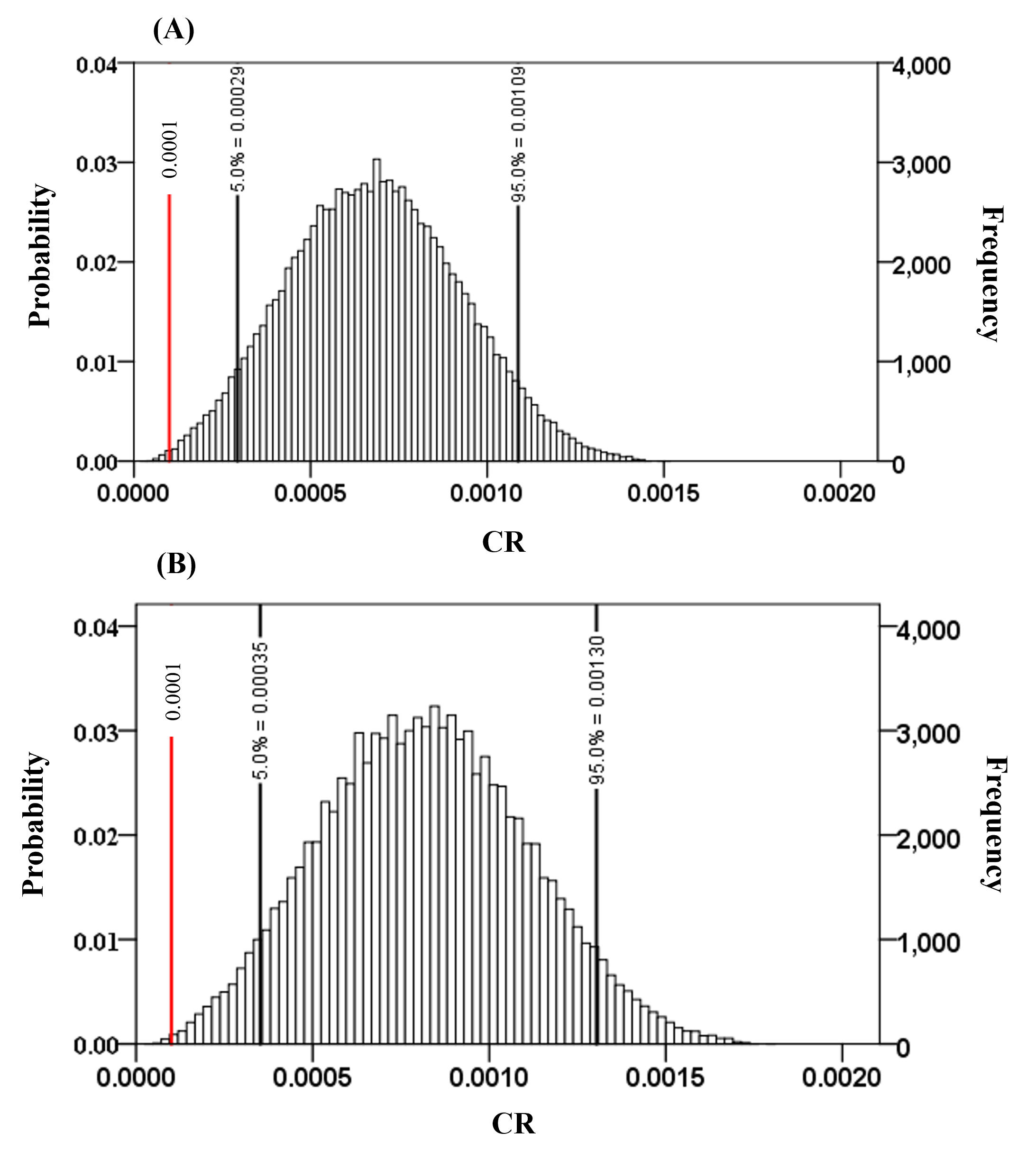
Supalak Kongsri
Nuclear Technology Research and Development Center (NTRDC), Thailand Institute of Nuclear Technology (Public Organization), 9/9 Moo 7, Saimoon, Ongkharak, Nakhon Nayok 26120, Thailand
Chunyapuk Kukusamude
Nuclear Technology Research and Development Center (NTRDC), Thailand Institute of Nuclear Technology (Public Organization), 9/9 Moo 7, Saimoon, Ongkharak, Nakhon Nayok 26120, Thailand
DOI: https://doi.org/10.14456/apst.2025.66
Keywords: Arsenic Carcinogenic risks Estimated weekly intake INAA Thai population
Abstract
The concentration of arsenic (As) in fifty brown rice samples was analyzed using instrumental neutron activation analysis (INAA). The samples were irradiated for seven hours at the Thai Research Reactor (TRR-1/M1) in Bangkok, Thailand. After neutron irradiation, the gamma-ray intensity of the samples was measured using a high-purity germanium (HPGe) detector. The average As concentration found in the brown rice samples was 0.217 mg/kg. The As levels in the studied samples were below the Codex maximum permissible level of inorganic As (0.35 mg/kg). The estimated weekly intake (EWI) of As via brown rice consumption for males (3.176 µg/kg BW/week) and females (3.809 µg/kg BW/week) was below the previously established provisional tolerable weekly intake (PTWI) of 15 µg/kg BW. Thus, the findings suggest that the Thai population is not at significant risk of As exposure through brown rice consumption based on the EWI. However, the carcinogenic risk for both Thai males and females exceeded the acceptable risk threshold (10⁻⁴), indicating a potential health concern over a lifetime of rice consumption.
How to Cite
Kongsri, S., & Kukusamude, C. (2025). Arsenic concentrations in brown rice and health risk assessment. Asia-Pacific Journal of Science and Technology, 30(04), APST–30. https://doi.org/10.14456/apst.2025.66
References
Fukagawa NK, Ziska LH. Rice: Importance for Global Nutrition. J Nutr Sci Vitaminol. 2019;65: S2-S3.
Principal rice exporting countries worldwide in 2023/2024. [Internet]. 2024 [cited 2024 Feb 23]. Available
Kukusamude C, Sricharoen P, Limchoowong N, Kongsri S. Heavy metals and probabilistic risk assessment via rice consumption in Thailand. Food Chem. 2021; 334:127402.
7 Amazing health benefits of brown rice. [Internet]. 2023 [cited 2024 Feb 23].
Kukusamude C, Kongsri S. Elemental and isotopic profiling of Thai jasmine rice (Khao Dawk Mali 105) for discrimination of geographical origins in Thung Kula Rong Hai area, Thailand. Food Control. 2018; 91:357-364.
Hasanuzzaman M, Nahar K, Hakeem KR, Öztürk M, Fujita M. Arsenic toxicity in plants and possible remediation. Soil Remed Plants. 2015;433-501.
An Y, Gao Z, Yang S, Liang J, Feng, Y, Kato K. Immunohistochemical analysis of oxidative DNA damage in arsenicrelated human skin sample from arsenic-contaminated area of Chaina. Cancer Lett. 2004;214(1):11-18.
Mandal P. An insight of environmental contamination of arsenic on animal health. Emer. Contam. 2017; 3:17-22.
Guha Mazumder DN. Chronic arsenic toxicity & human health. Indian J. Med. Res. 2008; 128:436-447.
WHO. Preventing disease through healthy environments exposure to arsenic: A major public health concern. Geneva: WHO; 2019.
Hassan J, Koohi MK, Amrollahi-Sharifabadi M, Funmlola SO. A review: Analytical methods and health risk assessment for inorganic, organic, and total arsenic content in rice samples. Anal Methods Environ. Chem J. 2023;6(2):85-108.
Silalahi J, Tampubolon SDR, Sagala MRM, Saraswati IN, Silalahi YCE. Analysis of arsenic in raw and cooked rice by atomic absorption spectrophotometer. IOP Conf. Series: Earth Environ Sci. 2018: 205:012040.
Phimol P, Visuthismajarn P, Lin C, Rukku S. Assessment of Arsenic Concentrations and Estimated Daily Intake of Arsenic from Rice (Oryza sativa) in Ron Phibun District, Southern Thailand. Int J Environ Sci. Dev. 2017;8(7):517-520.
Hensawang S, Chanpiwat P. Health impact assessment of arsenic and cadmium intake via rice consumption in Bangkok, Thailand. Environ Monit Assess. 2017;189(11):599.
Shraim AM, Ahmad MI, Rahman MSF, Ng JC. Concentrations of essential and toxic elements and health risk assessment in brown rice from Qatari market. Food Chem. 2022; 376:131938.
Nookabkaew S, Rangkadilok N, Mahidol C, Promsuk G, Satayavivad J. Determination of arsenic species in rice from Thailand and other Asian countries using simple extraction and HPLC-ICP-MS analysis. J. Agric. Food Chem. 2013;61(28):6991–6998.
Sakib KN, Das S, Islam MdT, Islam J, Tasnim MdM, Mian MdS, et al. Determination of Arsenic (As) Concentration in different varieties of Bangladeshi rice using neutron activation analysis (NAA). Environ. Earth Sci. 2017;7(6):70-77.
Seeprasert P, Anurakpongsatorn P, Laoharojanaphand S, Busamongkol A. Instrumental neutron activation analysis to determine inorganic elements in paddy soil and rice and evaluate bioconcentration factors in rice. Agr Nat Resour. 2017; 51:154-157.
Jafari A, Kamarehie B, Ghaderpoori M, Khoshnamvand N, Birjandi M. The concentration data of heavy metals in Iranian grown and imported rice and human health hazard assessment. Data in Brief. 2018;16: 453–459.
U.S. Environmental Protection Agency (U.S. EPA), 1988. Integrated Risk Information (IRIS). Arsenic, inorganic; CASRN7440-38-2.
Codex Alimentarius Commission, Joint FAO/WHO Food Standards Programme, Codex Committee on Contaminants in Foods. CF/14 INF/1. [Internet]. 2021 [cited 2024 Feb 23].
EFSA. Dietary exposure to inorganic arsenic in the European population. EFSA J. 2014; 12:3597.
USDA Foreign Agricultural Service, 2023. Grain and Feed Annual. Report Number: TH2023-0015.
NECTEC. SizeThai [Internet]. 2006 [cited 2024 Oct 14].
FAO/WHO (Food and Agriculture Organization/ World Health Organization). Seventy-second meeting. Summary and conclusions. JECFA/72/SC. [Internet]. 2010 [cited 2024 Feb 23].
Food and Drug Administration (FDA), U.S. Department of Health and Human. Arsenic 407 in rice and rice products: risk assessment report. [Internet]. 2016 [cited 2024 Feb 23].

Published:
License
This work is licensed under a Creative Commons Attribution-NonCommercial-NoDerivatives 4.0 International License.
